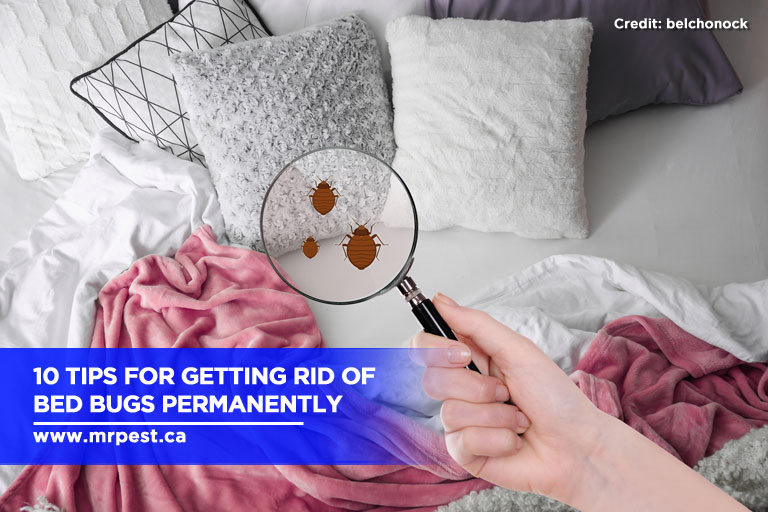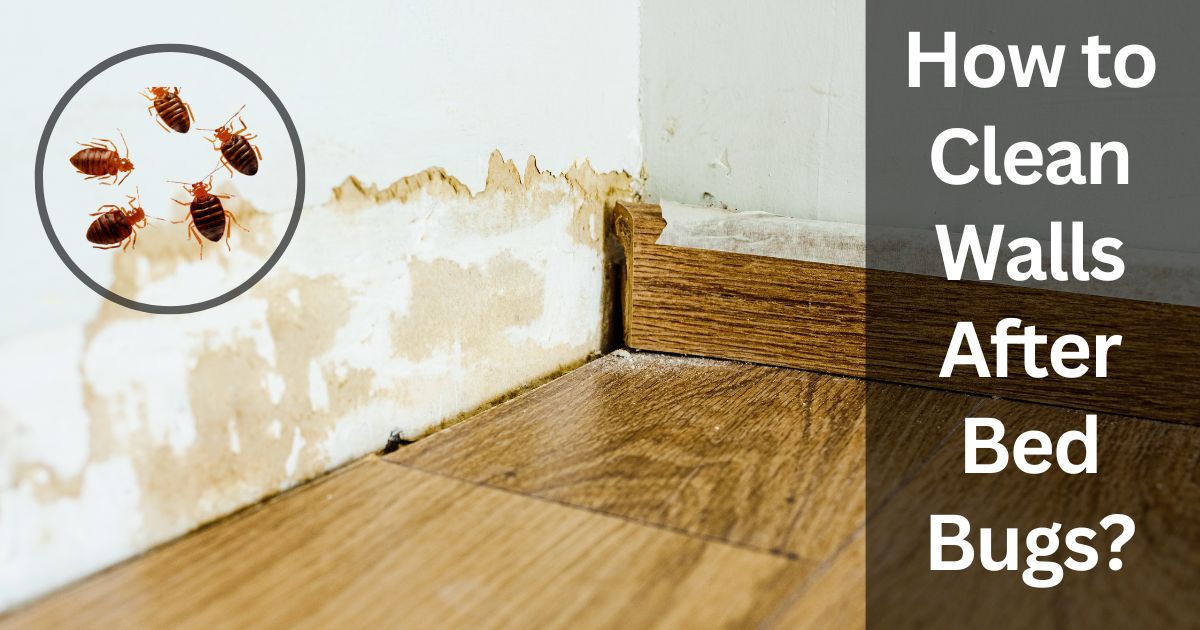To clean walls after bed bugs, use a mixture of soap and water followed by rubbing alcohol. Ensure thorough cleansing to prevent reinfestation.
Dealing with bed bugs can be an exhausting process. Once the pests are eliminated, it’s essential to clean your walls to remove any traces and prevent them from returning. This task should not be overlooked as bed bugs can hide in tiny crevices and behind wall fixtures.
After the initial cleaning with soapy water, disinfecting the areas with rubbing alcohol is an effective way to kill any lingering insects or eggs. Ensuring that your cleaning methods reach all potential hiding spots is critical to maintain a bed bug-free environment. Regular cleaning and vigilance will go a long way in keeping these pests at bay post-infestation.

Credit: www.mrpest.ca
Introduction To Bed Bug Infestations
Bed bugs can turn peaceful sleep into a distressing ordeal. These tiny pests thrive in the nooks of our bedrooms. Discovering bed bugs means it’s time for a thorough cleanup. Let’s explore how to identify an infestation and minimize its impact on your home.
Identifying A Bed Bug Problem
To tackle bed bugs, identify them early. Look for signs like:
- Small, itchy bites on your skin
- Dark spots on your mattress (bed bug feces)
- Blood stains on your sheets
- Live bugs around the bed area
Impacts On Your Home Environment
Bed bugs affect more than just sleep. They can cause:
| Allergic reactions | From bites leading to itching and discomfort |
| Anxiety and stress | Due to the persistent nature of the infestation |
| Damage to property | As they hide in furniture and walls |
Before You Begin The Cleaning Process
Discovering bed bugs in your home can be distressing. After taking care of the infestation, it’s crucial to clean your walls properly. This step eliminates traces of bed bugs and prevents them from returning. Start with safety and choosing the right tools for effective cleaning.
Safety Precautions
Before tackling bed bug traces, safety comes first. Protect yourself to avoid irritation from cleaning solutions and bed bug remnants. Here’s a checklist to ensure your safety:
- Wear gloves: Shield your hands from cleaners and allergens.
- Use a face mask: Avoid inhaling dust and disinfectants.
- Eye protection: Guard your eyes against splashing liquids.
- Well-ventilated area: Ensure fresh air circulation to disperse fumes.
Choosing The Right Cleaning Supplies
Selecting appropriate cleaning agents is critical. Use supplies that effectively remove stains while safeguarding your wall’s finish. Consider these options:
- Mild soap – Effective yet gentle on painted surfaces.
- Disinfectant cleaners – Kill germs and prevent new infestations.
- White vinegar – A natural, non-toxic alternative.
- Warm water – Helps in diluting and applying cleaners.
- Soft cloths and sponges – Prevents damage during scrubbing.
Equip yourself with the right gear and supplies and you’re set to begin the cleaning journey. A clean, bed bug-free wall ensures a safer and more pleasant living environment.
Initial Steps To Tackle The Aftermath
Dealing with bed bugs is tough. Once they’re gone, the cleanup begins. Tackling the aftermath correctly is essential for a clean and safe home environment.
Stripping The Area
Begin with clearing the room. Everything near bed bug zones needs attention. Start with furniture, curtains, and items on the wall. Keep in mind, electronics and art may require special handling. This is just the first step in the battle against these bugs.
Securing Contaminated Linens And Fabrics
Next, focus on linens and fabrics. They need secure handling. Grab a trash bag. Place all bed linens, curtains, and clothing inside. Seal them tight. It’s essential to wash these items in hot water later to kill lingering bugs. Transport them straight to the washing machine. Do not let them touch any other surfaces to prevent re-infestation.

Credit: bedbugheatspecialist.com
Deep Cleaning Your Walls
Bed bugs are notoriously hard to eliminate, and their presence lingers even after they’re gone. If bed bugs infested your walls, a deep clean is essential to ensure they don’t return. Let’s explore how to purify your walls to restore the peace and cleanliness of your space.
Dry Cleaning Solutions
Before introducing moisture, start with a dry cleaning method:
- Vacuum walls with a HEPA filter to trap bed bugs.
- Use a microfiber cloth or soft brush attachment to prevent wall damage.
- Focus on cracks and crevices, where bugs may lurk.
Dispose of the vacuum bag or empty the canister outside immediately.
Using Wet Cleaning Techniques
After dry cleaning, move to wet methods:
- Mix a mild detergent with water.
- Use a sponge or cloth to gently wash the walls.
- Rinse with a clean, damp cloth.
For tough spots, a 90% isopropyl alcohol solution works. Always test a small area first to prevent damage. Open windows to ventilate the area.
Targeting Bed Bug Residue
Dealing with bed bugs can be stressful and after you’ve tackled the infestation, cleaning up is the next step. Cleaning walls after bed bug infestation is crucial. Residue from bed bugs, such as stains, spots, and egg deposits, can be nasty reminders of the infestation. Targeting Bed Bug Residue effectively ensures a clean and safe environment. Let’s break down the steps to restore your walls.
Eradicating Stains And Spots
Stains and spots from bed bugs on your walls can be unsightly. To remove these, start with a gentle cleaning solution. Mix a tablespoon of dish soap with a cup of warm water. Dip a soft cloth or sponge in the mixture and gently wipe the walls. For stubborn stains, use a mix of baking soda and water to create a paste. Apply the paste to the stain, let it sit for ten minutes, and wipe clean. Test any cleaner on a small area first to prevent damage.
Eliminating Egg Deposits
Bed bug eggs stick to surfaces and can lead to a recurring problem if not removed. Use a putty knife or a credit card to gently scrape off any visible eggs from the wall. Vacuum the area with a brush attachment to ensure all eggs are removed. After vacuuming, wipe down the wall with a hot water and vinegar solution. This solution can dissolve any sticky residue and sanitize the area. Empty the vacuum cleaner outside your home immediately after this process.
:max_bytes(150000):strip_icc()/Handle-bed-bug-infestation-laundry-2146304-V1-899a4efc4ca54972959fafa4c1263cf4.png)
Credit: www.thespruce.com
Focus On Cracks And Crevices
Bed bugs love hiding in tiny spaces. Cleaning these spots is critical. Pay extra attention to every corner. A thorough clean-up prevents bed bugs from returning.
Sealing And Patching Methods
First, inspect your walls. Look closely at the paint and wallpaper. If you find holes or cracks, it’s time to act. Here is a step-by-step guide:
- Clean the area with soapy water.
- Let it dry completely.
- Apply spackling paste to fill small holes.
- For larger gaps, use joint compound.
- After drying, sand the surface for a smooth finish.
- Paint or wallpaper over the patched area.
Treating Hard-to-reach Areas
Some wall areas are tricky. They need special attention. Use slim cleaning tools to reach them. Here’s how to do it:
- Vacuum with a crevice tool to get rid of bed bugs.
- Use an insecticide dust for long-term control.
- For areas behind moldings, a putty knife can help apply dust.
- Consider hiring a professional for the toughest spots.
Remember to wear gloves and a mask for safety. Always follow the insecticide directions.
Preventative Measures For The Future
Once your walls are clean and free of bed bugs, taking steps to prevent another infestation is crucial. By establishing a regular wall maintenance routine and considering protective coatings, you can create a bed bug-resistant environment. Implement the following strategies to safeguard your home.
Regular Maintenance Tips
- Inspect walls periodically for cracks or peeling paint that might harbor bed bugs.
- Clean behind furniture and in wall crevices to remove bed bug hiding spots.
- Vacuum around baseboards to suck up any eggs or stray bugs.
- Wash walls with a 50/50 water and vinegar solution monthly.
- Keep living areas uncluttered to reduce bed bug hideouts.
Protective Coatings And Treatments
Defend your walls using special treatments and protective coatings. These substances deter bed bugs and make walls less inviting.
| Coating/Treatment | Benefits |
|---|---|
| Diatomaceous Earth | Non-toxic powder that kills bed bugs. |
| Insecticide Paint Additive | Long-lasting protection mixed with paint. |
| Clear Bed Bug Spray | Easy to apply and dries invisibly. |
Remember to read labels and follow application instructions carefully. These treatments can greatly reduce the risk of a bed bug recurrence.
Dealing With Persistent Issues
Cleaning walls after a bed bug infestation requires diligence. Sometimes, bed bugs persist despite rigorous cleaning efforts. This section addresses common challenges and offers solutions to effectively combat these pesky invaders.
When To Call In Experts
Not all infestations can be tackled alone. Recognizing when professional help is needed is key to protecting your home. Consider experts if:
- Home treatments fail multiple times.
- New bites appear after cleaning.
- You find bed bug eggs in wall cracks.
Professional exterminators can identify and reach hidden colonies, ensuring a bed bug-free environment.
Long-term Strategies For Bed Bug Control
Maintaining a bed bug-free home requires ongoing actions. Here are strategies for long-term control:
- Regularly inspect for signs of bed bugs.
- Use protective mattress encasements.
- Vacuum frequently, especially near walls and furniture.
Prevent future infestations by sealing wall cracks and reducing clutter, where bed bugs hide.
Frequently Asked Questions For How To Clean Walls After Bed Bugs?
What Kills Bed Bugs On Walls Effectively?
Bed bugs can be eliminated from walls by using a combination of heat treatment, chemical sprays, and diatomaceous earth. Sprays with pyrethroids are often used for their effectiveness. Always follow label instructions and safety precautions.
How To Sanitize Walls After Bed Bug Removal?
After bed bug extermination, clean walls with soapy water followed by a disinfectant. Use a mixture of water and white vinegar or a commercial antibacterial spray. Ensure thorough drying to prevent mold growth.
Can Bed Bugs Infest Wall Cavities?
Yes, bed bugs can infest wall cavities, hiding in cracks and crevices. They travel through electrical outlets and under baseboards. Professional pest control is recommended to fully address infestations in such hidden areas.
What Are Signs Of Bed Bugs On Walls?
Look for rusty stains, bed bug feces (tiny black dots), shed skins, and egg shells on walls. Live bed bugs are also a clear sign. These indicate an active bed bug infestation on or near the walls.
Conclusion
Ridding your walls of bed bugs can be daunting, but with the right steps, you’ll ensure a clean, pest-free space. Remember, consistency and thoroughness are vital. Embrace this guide to tackle the aftermath of an infestation effectively. To maintain a bed bug-free home, stay vigilant and clean regularly.
Your peace of mind is worth the effort.
Related posts:

I’m MD Tanvir, and I bring years of expertise gained from working closely with pest control companies to the forefront. My journey in the industry has inspired me to launch Bug Battler, a platform aimed at equipping people with the know-how to combat pests autonomously. Through Bug Battler, I aim to empower individuals with practical insights to tackle pest infestations effectively.

